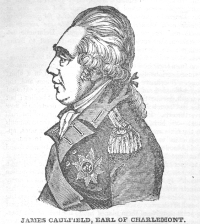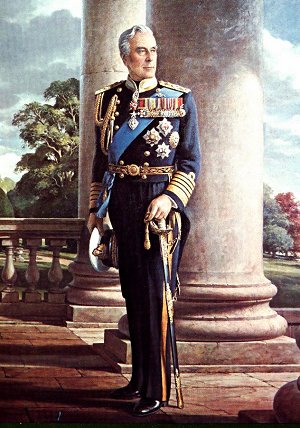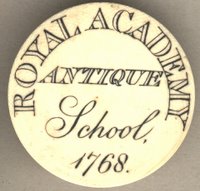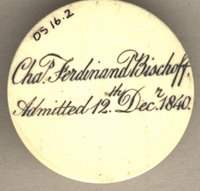The miniature portraits depicted here were purchased for the Artists and Ancestors collection, but are mostly examples which had not been added into the website due to the pressure of other research. They are now added as part of a New Year's Resolution to try to get up to date!
Those depicted represent a wide range of artist skills and variation in quality, but most appealed as examples to represent differing aspects of miniature collecting. Many of them would be shunned by collectors of expensive high quality miniatures, but the range shows what is available for purchase by a collector of more modest means. They all came from public auctions and in order of acquisition are as below.
ds
1489 is an Italian lady in provincial costume, where the detail of the
portrait is much finer than can be seen in the images. A kind expert in
Italy sent me the printed image of a similar costume, which shows the
costume comes from the region of Salerno. What looks like a signature is
actually a description. It was inexpensive appealed due to the
primitive, but finely detailed style

ds 1491 This fairly ordinary looking man has no great merit, He is probably French and came from a local auction along with the miniature on paper by John Smart previously separately added to the website.
 |
| ds 1490 by John Smart |
ds 1492 This miniature portrait came from the same auction as 1490 and 1491. Although not of high quality it is in a large ornate frame and interesting as it shows how artist used several pieces of ivory when they wanted to paint or enlarge a large miniature. This one appears to be an actress painted around 1820-30, and an expert on the theatre may be able to detect the role or play depicted.
The full sight size is 175mm by 120mm and to purchase a piece of ivory of that dimension would have been very expensive. Thus the main portrait is 130mm by 110mm, which is still large for a miniature. As the colours vary between the pieces, the extra ivory may have been added when it was reframed. There is no obvious signature, although it has not been opened.
[Later - a kind visitor has made a helpful suggestion about this miniature portrait: "While there is no way to be positive, I believe it could be a portrait of Mademoiselle Ekaterina Semyonova (also Catherine Semenova) costumed as Alina, Queen of Golconda. Semyonova was a principle Diva at the Imperial Theater of St. Petersburg where she played the role of Alina. Alina, Reine de Golconde with music by Francois-Adrien Boieldieu opened in St. Petersburg in 1804. The opera played throughout Europe from 1755 to 1898. The music in most cases was rewritten by a notable composer of the era and city in which it played. The famous Gaetano Donizetti wrote the music for the Genoa, Italy production in 1828."]
ds 1493 Another miniature of no great merit, but interesting for the level of detail depicted in a harbour scene.
ds 1494 This is an early 20C or late 19C portrait of King Frederick the Great, of no great quality, but unusual as a wax miniature of him.
ds 1495 was added separately to the website. It is by the American artist Charles Willson Peale and is a portrait of Colonel Charles Pope.
ds 1496 This miniature portrait is of Henry Penny Sale, youngest son of Sir Robert Sale GCB. Although on paper, it has an interesting inscription on the reverse. A bit hard to read, but apparently:
"Henry Penny Sale, youngest son of Sir Robert Sale GCB and Lady Sale, killed by a fall in the hills near Simla, India, b. 1829, died 1851. Lieutenant in the 13th Regiment of ft.. Adjutant of his regiment, aged nearly 22. At school at [Pl.orlong]? dean near Brightom Sussex with Major General William C Stileman, a son of the late R Stileman Esq. of the [Friends]? of Winchelsea, Sussex, where his grand-parents, George and Mary Wynch lived, also Mrs Vane."
See also Henry Penny Sale 1829-1851 - Ancestry.co.uk and
Sale - Lieutenant Henry Penny - 13th Bengal Native Infantry - died 30th April 1851.
Son of Major-General Sir Robert Henry Sale, GCB (killed at Mudki 1845). Served Punjab 1848 (medal and bar).
Grave at Subathu - "Sacred to the memory of Henry Penny Sale. Lieutt 13th Regt N.I. Adjt Nusseree Battn who died on the 30th April 1851 aged 24 years. Deeply regretted by his family and friends. This tablet was erected by his brother officers as a token of their esteem."

ds 1497 This miniature of a young lady is housed in a red leatherette case and is unusual as it was painted in South Africa. On the reverse it is signed J. E. Ford, Cape Town, 1825. Unfortunately the sitter is not identified, but it is finely painted, and interesting as an indication that London hair and clothing fashions of 1825 were quickly repeated in South Africa.
Ford flourished 1793-1830, and Foskett notes that Schidlof mentioned two portraits by him. An officer signed on the reverse J.E. Ford, Cape Town and another signed on the reverse. J.E. Ford, 1828. Thus this one of a young lady seems to be especially unusual in being signed with both the location and the date.

ds 1498 This miniature portrait of a young lady is a little smaller than usual for the time, c.1815, being 50mm by 40mm.
It is by an American artist and is in what I call a "make-do" case. That is it dates from about 1815, around the time of the war of 1812, when the Embargo Act was in place which prevented artists from getting supplies of new casework from England. Hence artist were forced to use what ever left over materials they could find to combine and produce "make-do" cases.
I have written elsewhere on how many dealers replace the cases of miniatures like this to make them more saleable, but as a historian, I believe they should be retained in their "make-do" cases, as a more honest condition and a reminder of the interesting history of events around the Embargo Act.
 It
was suggested her married name was possibly a Mrs Goadlow [Goodlow?]
and the rear is engraved with her initials, presumably when unmarried,
JWD or IWD, so there may be a faint chance of identifying her.
It
was suggested her married name was possibly a Mrs Goadlow [Goodlow?]
and the rear is engraved with her initials, presumably when unmarried,
JWD or IWD, so there may be a faint chance of identifying her.The artist is a puzzle, as the quality is high, but not easily recognisable. Possibilities include Raphael Peale, as the background colouring is similar to his work, Anson Dickinson, or Hugh Bridport.
The engraving on the rear of the case is not common and the tiny glass is another indication of the Embargo Act, as high quality glass was unavailable in America at the time. The brooch fitting is broken off, but is more recent, perhaps 20 years later.
ds 1499 This is another American miniature portrait from c.1820, again smaller than usual for the time, sight size 43mm by 35mm. It is a good example of an early American designed case, as a result of the Embargo Act, but still with proper materials in short supply.
When advertised it was described as "English oval framed 1770-1790, young man", but is definitely later and American, so is an indication that sellers often have inaccurate descriptions. Although the image is out of focus, the artist is perhaps Daniel Dickinson or Thomas Edwards.
ds
1500 This miniature portrait was merely described as, "Miniature
Etching Of
Distinguished Gentleman 19th Cent". Hence it was very cheap. However, it
was immediately obvious as a Saint Memin portrait, being inscribed at
the foot, "Drawn and Engr. by St. Memin, Philadd." see Charles Balthazar Julien Févret de Saint-Mémin - Wikipedia ...
With
such engraved portraits it is usually possible to identify the sitter
by reference to the book by Ellen G Miles which lists hundreds of
examples with their images, see Saint-Mémin and the neoclassical profile portrait in America
One
of the joys of collecting miniature portraits, although rarely
possible, is to take an unidentified sitter and so to speak "bring them
back to life".
This
one took a while to work through (thankfully his name was not Wyatt!),
before being matched with a portrait of William Poyntell, who died in
1811 and was an eminent merchant and publisher. There is an extensive
obituary for him in The Gentleman's Magazine, see The Gentleman's Magazine which opens:
"Sept
10 1811 Died at his house in Philadelphia, in his 56th year,
universally lamented, William Poyntell, esq. late Merchant, and one of
the Select Council of that city. He had retired from business several
years having acquired an ample fortune, of which he merited the
enjoyment by the most inflexible integrity in all his dealings and
transactions with whomsoever he was engaged. Mr Poyntell was an
Englishman, and his character holds forth so bright an example of
usefulness and private worth, that we are persuaded we shall stand
excused for entering upon it more at large. He was born at Chipping
Norton in Oxfordshire, and baptized in the parish church there, April 9,
1756. ...."
He sold stationery and wall papers, there being a picture of scales sold by him at The Price of Freedom: Money Scales and wallpaper at Stanley Y. Klos: Imlay Mansion There is a picture of his grave at William Poyntell (1756 - 1811) - Find A Grave Memorial and discussion of his art collecting activities at William Poyntell (1756–1811) - Springer and 'All my stained glass which I brought from Europe'
ds
1501 One sitter who was identified is in this silhouette portrait, Lord
Charlemont. There was a fashion for a while of using a silhouette
portrait of the sitter's face, but with coloured clothing, often for
those in uniform, as here.
The sitter is the Earl of Charlemont (1728-99), see James Caulfeild, 1st Earl of Charlemont - Wikipedia, the free ... He was well known for his love of Classical art and culture and spent nine years on the Grand Tour in Italy, Greece, Turkey and Egypt. He returned to Dublin and employed the Scottish architect Sir William Chambers to remodel his main residence Marino House, to design his town house Charlemont House and the unique Neo-Classical garden pavilion building, the Casino at Marino.
The sitter is the Earl of Charlemont (1728-99), see James Caulfeild, 1st Earl of Charlemont - Wikipedia, the free ... He was well known for his love of Classical art and culture and spent nine years on the Grand Tour in Italy, Greece, Turkey and Egypt. He returned to Dublin and employed the Scottish architect Sir William Chambers to remodel his main residence Marino House, to design his town house Charlemont House and the unique Neo-Classical garden pavilion building, the Casino at Marino.


There is a similar image of him at James Caulfield, Earl of Charlemont - Library Ireland together with an account of his life. And more about him with another portrait at The Armagh Election of 1753 - Craigavon Historical Societywhich is probably engraved from an original oil portrait.
ds 1502 This miniature of a young girl is believed to be American for several reasons, firstly as the reverse is solid metal and is engraved in large letters HTG, so perhaps her first name was Harriet. Solid backs on miniatures of this size, are occasionally met with in America, but practically never on British miniatures, it being 71mm by 58mm. Although it is a very similar pose to works by William Verstile or Lawrence Sully, it may be too late for either of them.

ds 1502 This miniature of a young girl is believed to be American for several reasons, firstly as the reverse is solid metal and is engraved in large letters HTG, so perhaps her first name was Harriet. Solid backs on miniatures of this size, are occasionally met with in America, but practically never on British miniatures, it being 71mm by 58mm. Although it is a very similar pose to works by William Verstile or Lawrence Sully, it may be too late for either of them.

 |
| Alexander Pope |
ds 1503 Alexander Pope has become increasingly relevant to my research into the life and works of the author, Tobias Smollett, so when this miniature portrait on ivory was offered on Ebay in 2015, as an "Unknown Gentleman", it was impossible to resist purchasing it.
It is after an earlier oil portrait of Pope by Thomas Hudson and is signed V.V.K.) Although after a well known portrait. The research into Smollett, his Lost Works ,and the War of the Satirists is extensively covered at The Lost Works of Tobias Smollett and the War of the Satirists and is the main reason for spending so little time on miniatures.
ds 1504 This pressed metal portrait, probably of a clergyman, is poor quality and very cheap, but I had hoped to identify the sitter and so make him more interesting. It is also over-painted, but he remains unidentified.
However, he must have been of some significance to have a medal pressed.
ds 1505 This better quality pressed metal portrait came from the same source. It appears to be gilded brass and is a portrait of Sir Sidney Smith. An extensive account of his life is at Sidney Smith (Royal Navy officer) - Wikipedia, the free ... There it is noted,
Admiral Sir William Sidney Smith, KCB, GCTE, KmstkSO, FRS (21 June 1764 – 26 May 1840) was a British naval officer. Serving in the American and French revolutionary wars, he later rose to the rank of admiral. Napoleon Bonaparte, reminiscing later in his life, said of him: "That man made me miss my destiny"
He was also active against the slave trade.
ds 1506 Continuing the naval theme is this miniature portrait of Lord Louis Mountbatten by Dorothy Turton, for Dorothy Barbara Jessie Turton RMS (1900-1900s).
Men in uniform are obviously much more colourful than those dressed in drab black coats of the 19C, but what is not immediately realised, is that those in uniform take a lot longer to paint, especially when, as here, there are many decorations, and a very detailed uniform.
The colouring of miniatures goes through fashions like many other things and this one is not as reddish as appears in the photo. The inscription on the rear reads:
Lord Louis Mountbattern, 1979, Dorothy Turton, £130, RMS, Exhibited in 1986 in The Mall Galleries, The Mall, London.
 That
was a lot of money at the time of 1979, which reflects the time that
must have been spent by Dorothy Turton on the detail, but only a little
different than the price it was able to be acquired at for this
collection. For much more about Mountbatten who was killed in a bomb
explosion on 27 August 1979, see Louis Mountbatten, 1st Earl Mountbatten of Burma - Wikipedia This portrait was presumably painted soon after he died as a copy from this large oil.
That
was a lot of money at the time of 1979, which reflects the time that
must have been spent by Dorothy Turton on the detail, but only a little
different than the price it was able to be acquired at for this
collection. For much more about Mountbatten who was killed in a bomb
explosion on 27 August 1979, see Louis Mountbatten, 1st Earl Mountbatten of Burma - Wikipedia This portrait was presumably painted soon after he died as a copy from this large oil.
 ds
1507 This miniature portrait was offered at a local auction with no
description other than being a portrait of a man. However, he was
interesting to me as I was able to read the faint writing on the reverse
as reading, "F.H. Bischoff, Painted by hinself." Foskett says only of
him "Bischoff, F.H. (fl. 1823-49) Of London.
Exhibited at the R.A. 1823-49. His address was in 1823 was 176 Sloan
Street, Knightsbridge."
ds
1507 This miniature portrait was offered at a local auction with no
description other than being a portrait of a man. However, he was
interesting to me as I was able to read the faint writing on the reverse
as reading, "F.H. Bischoff, Painted by hinself." Foskett says only of
him "Bischoff, F.H. (fl. 1823-49) Of London.
Exhibited at the R.A. 1823-49. His address was in 1823 was 176 Sloan
Street, Knightsbridge." This made him doubly interesting, firstly as self-portraits are always special and, secondly, the name Bischoff, as there are other portraits and items in this collection by Bischoff which were also purchased locally several years ago.

 In
particular in the collection there is a RA token engraved with the name of
Charles Ferdinand Bischoff (1820-1898), the son of the artist F H
Bischoff. Here are the front and reverse of his ivory ticket to the
Royal Academy. On the front is written "Royal Academy Antique School
1768" and on the reverse "Chas Ferdinand Bischoff - Admitted 12th Dec'r
1840".
In
particular in the collection there is a RA token engraved with the name of
Charles Ferdinand Bischoff (1820-1898), the son of the artist F H
Bischoff. Here are the front and reverse of his ivory ticket to the
Royal Academy. On the front is written "Royal Academy Antique School
1768" and on the reverse "Chas Ferdinand Bischoff - Admitted 12th Dec'r
1840".
ds 1508 The final portrait for the year was not the least. For some reason the auctioneers attributed it to John Smart, but it was immediately clear it was an early miniature portrait by George Engleheart (1750-1829). The sight size is only 39mm by 33mm and it was offered in an ordinary ebonised frame. However, inside it was still in its original bracelet fitting. The miniature is from his second period 1780-95, when he tended not to sign his work and was the period of which Foskett writes, "his full powers developed, his colouring became strong, his draughtsmans hip was good and although he still used small ivories, the quality of the work was excellent."

It is not expected to have as many additions during 2016.



















4 comments:
Hello Don! I was interested to see that you got a print of the Saint-Mémin portrait of my 5th great-grandfather William Poyntell. I'm familiar with the image, and have a digital version of it. This may be a dumb question (I'm not terribly expert about this kind of art), but... what you got is a print of the portrait, right? Or is that actually the original drawing/engraving?? Nice blog, by the way -- I enjoyed perusing it.
Hi Derek,
Thank you for the kind comment and am glad to know the portrait is of interest. The way St Memin generally worked seems to have been prepare a larger portrait and then produce engraved copies of it. I suggest you do a Google images search on "saint memin portrait" where you can see examples.
He sold the larger portrait to the sitter, and engraved a number of smaller copies of it as part of the commission. These the sitter could distribute to friends and family. The engraving I have is one of those smaller copies, but there are also much later engraved copies, based upon photographs of the original set of engravings.
Derek and Don Shelton: Derek, this is Sharon Kemper, I believe I have the originals (large) portrait of William Poyntell and his wife. 7-10-18
ds1504 - we have an unpainted version from a old cousin and she has annotated it ' Bishop Ken' - i.e. bishop thomas ken. He was bishop of bath and wells and as my cousin was born and raised in Shepton Mallet, that would ring true.
Post a Comment